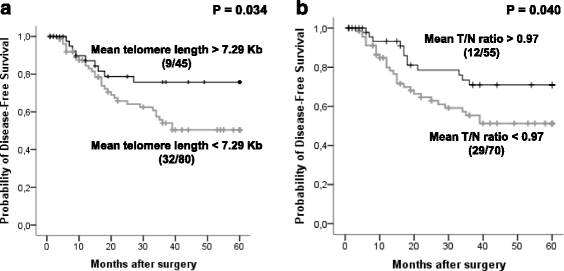Telomere length and telomerase activity in non-small cell lung cancer prognosis: clinical usefulness of a specific telomere status
- PMID: 26250468
- PMCID: PMC4528384
- DOI: 10.1186/s13046-015-0195-9
Telomere length and telomerase activity in non-small cell lung cancer prognosis: clinical usefulness of a specific telomere status
Abstract
Background: Considering previous data and the need to incorporate new biomarkers for the prognosis of solid tumours into the clinic, our aim in this work consists of evaluating the potential clinical use of telomeres and telomerase in non-small cell lung cancer (NSCLC).
Methods: Telomere status was established by determination of telomere length using the Terminal Restriction Fragment length method, and telomerase activity by the Telomeric Repeat Amplification Protocol in 142 NSCLCs and their corresponding control samples, obtained from patients submitted to surgery. Group-oriented curves for disease-free survival were calculated according to the Kaplan-Meier method considering telomere length, T/N ratio (telomere length in tumour to control tissue) and telomerase activity.
Results: Overall, tumours had significantly shorter telomeres compared with telomeres in control tissues (P = 0.027). More than 80 % of NSCLCs displayed telomerase activity. Regarding prognosis studies, patients whose tumours showed a mean telomere length (MTL) <7.29 Kb or T/N ratio <0.97 showed a significantly poor clinical evolution (P = 0.034 and P = 0.040, respectively). As result of a Cox multivariate analysis including pathologic state and lymph node dissemination, the MTL and T/N ratio emerged as independent significant prognostic factors.
Conclusions: Telomerase activity was identified as a marker of poor prognosis. The novel finding of this study is the independent prognosis role of a specific telomere status in NSCLC patients. According to our results, telomere function may emerge as a useful molecular tool that allow to select groups of NSCLC patients with different clinical evolution, in order to establish personalized therapy protocols.
Figures


References
-
- Ferlay J, Soerjomataram I, Ervik M, Dikshit R, Eser S, Mathers C, et al. GLOBOCAN 2012 v1.0, Cancer Incidence and Mortality Worldwide: IARC Cancer Base No. 11. Lyon, France: International Agency for Research on Cancer; 2013. Available on http://globocan.iarc.fr
Publication types
MeSH terms
Substances
LinkOut - more resources
Full Text Sources
Other Literature Sources
Medical
Research Materials

